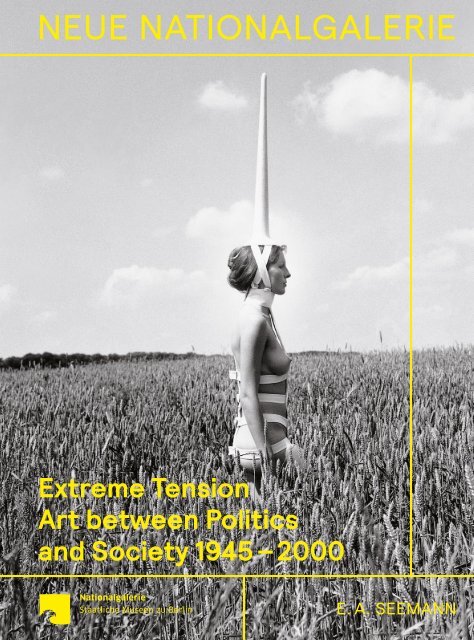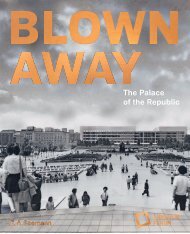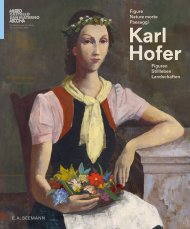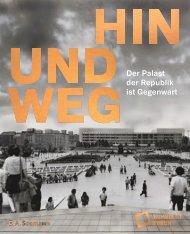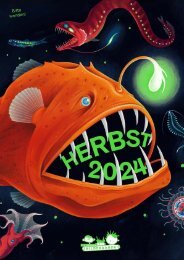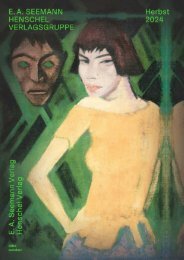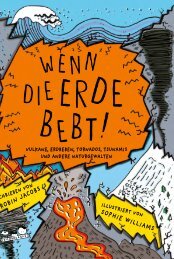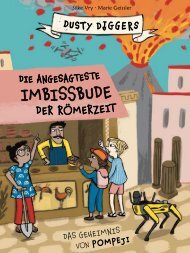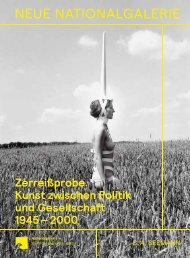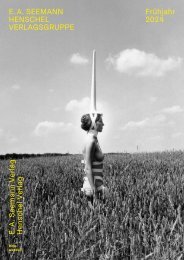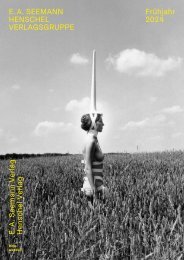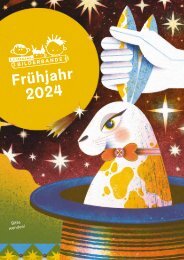9783865025159_Extreme_Tension
Create successful ePaper yourself
Turn your PDF publications into a flip-book with our unique Google optimized e-Paper software.
NEUE NATIONALGALERIE<br />
<strong>Extreme</strong> <strong>Tension</strong><br />
Art between Politics<br />
and Society 1945 – 2000<br />
E. A. SEEMANN
<strong>Extreme</strong> <strong>Tension</strong><br />
Art between Politics<br />
and Society<br />
The Nationalgalerie<br />
Collection<br />
1945 – 2000<br />
For the Nationalgalerie, Staatliche Museen zu Berlin,<br />
edited by Joachim Jäger, Marta Smolińska<br />
and Maike Steinkamp<br />
E. A. SEEMANN
CONTENTS
6 Foreword<br />
Klaus Biesenbach<br />
8 <strong>Extreme</strong> <strong>Tension</strong>: Art between Politics<br />
and Society 1945 – 2000<br />
Joachim Jäger, Marta Smolińska,<br />
Maike Steinkamp<br />
26 Abstraction / Figuration<br />
36 Socialist Realism<br />
50 Abstraction as a Universal Language?<br />
168 Battlefield Germany<br />
176 Nature / Culture<br />
182 Art as Environmental Protection –<br />
Agnes Denes<br />
204 Analogue Systems<br />
210 The Computer as a Medium –<br />
Horst Bartnig<br />
220 From the Factory<br />
72 Existential Experiences<br />
80 Response to the Fears of the World –<br />
Wifredo Lam<br />
224 Shouting to the Point of Exhaustion<br />
238 An Unjustly Forgotten Conceptual<br />
Artist – Bernadette Bour<br />
88 The Performative Image<br />
100 Feminist and Embodied Painting –<br />
Carolee Schneemann<br />
244 Freeing the Body<br />
252 Feminist Interventions in Socialism –<br />
Ewa Partum<br />
104 Everyday Life Becomes Art<br />
108 Expansion of the Pictorial Space –<br />
Lucio Fontana<br />
122 Sweet Wall<br />
128 Pop and Propaganda<br />
136 “Pop”-Propaganda – Willi Sitte<br />
148 A More Beautiful Life<br />
158 An Uncanny World of Things –<br />
Konrad Klapheck<br />
166 Hair<br />
266 <strong>Extreme</strong> <strong>Tension</strong><br />
270 Fluid Identities<br />
286 Rebellious Self-Stagings –<br />
Sarah Lucas<br />
292 List of Works<br />
301 Image Credits<br />
303 Acknowledgements
FOREWORD<br />
6<br />
Yoko Ono<br />
Cut Piece<br />
1964/65
The Neue Nationalgalerie is home to the art of the twentieth century. The Nationalgalerie’s<br />
extensive and many-faceted collection is closely linked to Germany’s and<br />
Europe’s contemporary history. Berlin in particular has always been at the centre of<br />
social and political events. Already in our previous presentation of the collection, with its<br />
focus on classical modernism, the theme was The Art of Society. This new presentation<br />
is devoted to art after 1945 and once again places it in relationship to the social and<br />
political developments of the time. Here, <strong>Extreme</strong> <strong>Tension</strong>, the title of Günter Brus’s<br />
radical 1970 performance, serves as the guiding theme.<br />
Performance, film and video grew considerably in importance from 1960 onwards.<br />
Key works such as Freeing the Body by Marina Abramović, Semiotics of the<br />
Kitchen by Martha Rosler or Unicorn by Rebecca Horn therefore form part of<br />
the new presentation. The importance of remembering central performances<br />
is demonstrated by the re-presentation of Yoko Ono’s Cut Piece at the Neue<br />
Nationalgalerie in September 2023, which was created in close consultation<br />
with the artist. There was great public interest in the performance, thanks to<br />
its continued relevance today. Simultaneously, the museum showed a historical<br />
video of the performance from 1964, which we have now integrated into the<br />
new collection display.<br />
Our main goal is to present the art of the twentieth century in the greatest<br />
possible variety and diversity. We have succeeded in substantially increasing<br />
to 25 percent the proportion of women artists shown. For now, some of<br />
their works complement the presentation as loans. We intend to permanently<br />
incorporate them into the collection, so far as it is possible to do so. In this<br />
sense, the presentation is also an essential step toward the creation of “ Berlin<br />
Modern” – our new museum expansion, which, together with the glass and<br />
steel building by Mies van der Rohe, will present the art of the twentieth century<br />
in all its complexity and diversity.<br />
Sincere thanks are due to the curators Joachim Jäger, Marta Smolińska and<br />
Maike Steinkamp, and to the entire team of the Neue Nationalgalerie and the<br />
Hamburger Bahnhof – Nationalgalerie der Gegenwart. We also want to extend<br />
our heartfelt thanks to the many partners from outside the Nationalgalerie,<br />
the graphic designers from Any Studio, the E. A. Seemann Verlag and especially<br />
the artists and their estates for their friendly and close cooperation.<br />
Klaus Biesenbach<br />
Director<br />
7
EXTREME TENSION<br />
ART BETWEEN POLITICS<br />
AND SOCIETY<br />
1945 – 2000<br />
Joachim Jäger, Marta Smolińska, Maike Steinkamp<br />
The art of the second half of the twentieth century is characterised by great<br />
contradictions and an enormous variety of media and artistic strategies. At<br />
the same time, scarcely any other age has been so marked by division and turmoil,<br />
and also by renewal. The aftermath of Holocaust and war, the subsequent<br />
spirit of optimism, liberation movements and the Cold War led not only to social<br />
friction but also to fundamental realignments in the visual arts. The exhibition<br />
<strong>Extreme</strong> <strong>Tension</strong>: Art between Politics and Society 1945 – 2000 shows central<br />
works from the collection of the Nationalgalerie from 1945 to the turn of the<br />
millennium. The title <strong>Extreme</strong> <strong>Tension</strong> refers to the radical 1970 performance by<br />
Viennese Actionist Günter Brus, in which he not only pushed himself to his own<br />
physical limits, but at the same time pointed at the intense tensions permeating<br />
society, politics and art. It was the age of the Cold War, with its ideological<br />
confrontations between East and West, between abstraction and figuration,<br />
between traditional art genres and new artistic techniques and media. In<br />
this exhibition, the term “extreme tension” stands for the radical departures<br />
and upheavals in post-war art. Borrowing the words of French philosopher Paul<br />
Ricœur, it serves as a “living” metaphor, one that allows meaning to emerge.<br />
Through it, opposing phenomena enter into productive tension with each other,<br />
defy their literal meanings and question established categories. 1<br />
8
The exhibition is a continuation of the previous presentation of the collection,<br />
which focused on the first half of the twentieth century and – in the context<br />
of political, historical and social phenomena – questioned the classical narrative<br />
of the history of modern art. 2 The point of departure for both exhibitions is<br />
the Nationalgalerie’s unique collection, which was, in turn, significantly shaped<br />
by the historical conditions in a divided Germany. Not only does the collection<br />
reveal the different ideas of art and the different political value systems<br />
that emerged internationally after the Second World War, but at the same time<br />
it makes visible the history of an institution that existed in both East and West<br />
Germany. With the end of the Second World War and the founding of the two<br />
German states in 1949, a dual collection structure started to take form. From<br />
then on, the collections in East and West Berlin grew and developed independent<br />
of each other, each subject to its own side’s political conditions, guidelines<br />
and strategies.<br />
Andy Warhol<br />
Hammer and Sickle<br />
1976<br />
9
DIVIDED HISTORY / DIVIDED COLLECTION<br />
Shortly after the war ended, however, it still looked like there was a common<br />
path. In 1946 Ludwig Justi was appointed director of the former Staatliche<br />
Museen zu Berlin (Berlin State Museums), which included the Nationalgalerie<br />
(National Gallery). Justi had already directed the Nationalgalerie from 1909 to<br />
1933 but was removed from office when the National Socialists came to power<br />
in 1933. The collection of modern art he assembled was almost entirely broken<br />
up through the “Degenerate Art” confiscations of 1937. 3 After 1945, Justi<br />
re-established the tradition of a modern art collection. Together with Adolf<br />
Jannasch he developed plans for a new “gallery of the twentieth century”. 4 Yet<br />
the attempt failed in 1949 due to the founding of the Federal Republic of Germany<br />
(West Germany) and the German Democratic Republic (East Germany), and the<br />
resulting division of Berlin. The Nationalgalerie’s building was located on the<br />
Museum Island in the Soviet sector of the city, now East Berlin, but it only held<br />
part of the collection. Many objects had been moved to West Germany during<br />
the war; these found their way back to West Berlin during the 1950s. At the<br />
same time, also in the West, Adolf Jannasch continued to pursue the idea of<br />
a “gallery of the twentieth century”. As its director, he had acquired over<br />
150 works of art by 1954. Central to his collecting activities was, on the one<br />
hand, making amends to the artists who the Nazis had defamed as “degenerate”<br />
and, on the other hand, representing the ‘living connection between the art<br />
of our time and our culture as a whole’. 5 He wanted to open the collection to<br />
contemporary art – understood as the contemporary art of the West. In 1967,<br />
Jannasch’s “gallery of the twentieth century” was merged with the holdings of<br />
the Nationalgalerie that had remained in the West. 6 In 1968, this part of the<br />
collection found its home in the Neue Nationalgalerie, built by Ludwig Mies van<br />
der Rohe. Its opening on 15 September 1968 was a widely visible signal. Finally,<br />
West Berlin could pride itself on a prestigious museum and exhibition building.<br />
While West Berlin continued to strive to establish a “gallery of the twentieth<br />
century”, in the eastern part of the city, Justi gradually had to abandon the idea<br />
in light of a GDR art policy oriented towards Socialist Realism. The works of<br />
contemporary art that Justi had acquired in the first post-war years entered<br />
the holdings of the Nationalgalerie on the Museum Island, which had been<br />
reopening in sections since June 1949, but under the restrictive art doctrine of<br />
the early 1950s the works could not be displayed. 7 Later the original Nationalgalerie<br />
building would be entirely devoted to the art of the nineteenth century,<br />
with works from the twentieth century moved into the neighbouring Altes<br />
10
11<br />
Zofia Kulik<br />
KwieKulik: Marx Now<br />
1983
social disunity. In dealing with the collection, this “extreme tension” ultimately<br />
includes not only political issues, but also the question of the degree to which<br />
certain ideas or ideologies obstruct or restrict the view of art – a question<br />
that we must continuously ask. In this respect, the collection of the Nationalgalerie<br />
reveals a particular inner complexity that distinguishes it from many<br />
other European museums. The encounter of such fundamentally different artistic<br />
positions and approaches is unique. Highlighting these contrasts and this<br />
diversity is a crucial concern of the exhibition.<br />
22
23<br />
Barbara Kruger<br />
Untitled (My People Are<br />
Better than Your People)<br />
1994/2016
The Soviet Union blocks all<br />
access roads to West Berlin.<br />
Children observe the landing<br />
manoeuvre of a so-called<br />
Raisin Bomber of the Allies<br />
at Tempelhof Airport, which<br />
supplies West Berlin with food.<br />
1948<br />
Liberation of the Vaihingen<br />
concentration camp near Strasbourg<br />
1945<br />
28
View of the destroyed city centre<br />
of Warsaw after the bombardment<br />
by German troops at the end of the<br />
Second World War<br />
1945<br />
Division of Germany after<br />
the Second World War by the<br />
victorious powers<br />
1945<br />
29
Wilhelm Lachnit<br />
Manikin<br />
1948<br />
32
Victor Brauner<br />
Figures at the Beach<br />
1955<br />
Leonora Carrington<br />
Ladies Run, There Is a Man<br />
in the Rose Garden<br />
1948<br />
33
SOCIALIST<br />
REALISM<br />
Horst Strempel’s work Clear the<br />
Rubble … Rebuild! in the Berlin<br />
train station on Friedrichstraße.<br />
The mural is already painted<br />
over in 1951.<br />
1948<br />
36
art, there is a call for a forward-looking,<br />
realist form of<br />
expression in the model of the<br />
Socialist Realism that was already<br />
mandated in the Soviet Union<br />
since 1934.<br />
The escalation of the Cold War<br />
and Germany’s division in 1949<br />
into two separate countries –<br />
the Federal Republic of Germany<br />
in the West and the German Democratic<br />
Republic in the<br />
East – have a direct influence on<br />
art. Already in the years preceding<br />
this division, cultural policy in<br />
the Soviet-occupied zone, later<br />
East Germany, has a stronger<br />
socialist orientation. This is also<br />
true for the Eastern European<br />
republics forming concurrently,<br />
such as Poland and Hungary. In<br />
Socialist Realism follows an easily<br />
understandable visual programme<br />
with subject matter consistent<br />
with socialism’s political goals.<br />
Expressive and abstract tendencies<br />
are increasingly rejected as<br />
formalist, bourgeois and decadent.<br />
In the “formalism debate”<br />
of the years 1948 to 1953 there<br />
are tenacious disputes in East<br />
Germany about the direction of<br />
art. The formalism debate even<br />
affects artists who hold a positive<br />
view of East German politics.<br />
Horst Strempel, for example,<br />
sees his mural Clear the Rubble …<br />
Rebuild!, painted in 1948 in the<br />
Berlin train station at Friedrichstrasse<br />
and highly acclaimed at<br />
the time, painted over in February<br />
1951. Even Fritz Cremer’s portrait<br />
of the miner Franz Franik (fig.<br />
p. 41), depicted so realistically and<br />
37
US-American nuclear tests:<br />
underwater detonation<br />
of a nuclear weapon in the<br />
Pacific Bikini Atoll<br />
1946<br />
74<br />
French philosopher Jean-Paul Sartre<br />
is considered the leading exponent<br />
of existentialism. His main work<br />
Being and Nothingness is published<br />
in 1943.<br />
Around 1947
Stones against tanks: the<br />
East German Uprising of 17 June.<br />
Two young men throw paving<br />
stones at a Soviet tank on<br />
Leipziger Straße in East Berlin.<br />
1953<br />
Helene Weigel performing in<br />
Mother Courage and Her Children<br />
at the Deutsches Theater, East<br />
Berlin. The production is<br />
exemplary for Bertolt Brecht’s<br />
concept of epic theatre.<br />
1949<br />
Korean War: a child stands<br />
between two tanks destroyed<br />
by the North Korean army in<br />
a South Korean village.<br />
1951<br />
75
FEMINIST<br />
AND EMBODIED<br />
PAINTING – CAROLEE<br />
SCHNEEMANN<br />
In the 1970s Carolee Schneemann<br />
reacts to male-dominated<br />
abstract expressionism with a<br />
series of feminist performances.<br />
Within this art movement, artists<br />
focus on the painterly gesture,<br />
often with reference to Surrealism.<br />
Schneemann’s Up to and<br />
Including Her Limits is a key performance<br />
from these years.<br />
The artist performs it nine times<br />
between 1971 and 1976. In it, she<br />
hangs naked from a tree-climbing<br />
harness and draws lines on the<br />
surfaces around her. During the<br />
100
Carolee Schneemann<br />
Up to and Including<br />
Her Limits<br />
1976<br />
101
Tadeusz Kantor<br />
Infanta<br />
1966<br />
104
EVERYDAY LIFE<br />
BECOMES ART<br />
The 1950s are marked by a robust economic boom in Western<br />
Europe and the USA. More and more goods and products<br />
appear on the market, are used and disposed of, creating<br />
a throwaway society. The many things with which people, especially<br />
in the cities, surround themselves, also change the way<br />
culture is understood. Whether in theatre, music or the visual<br />
arts, increasing numbers of artists seek ways to integrate<br />
the everyday world into their work.<br />
In Italy, Lucio Fontana cuts up his canvases. The seemingly<br />
harmless cut through the middle of the canvas actually represents<br />
a radical stress test for art. Suddenly the image becomes<br />
an object. Beginning in New York and Paris, and soon in many<br />
other cities, artists begin to take an interest in used everyday<br />
objects. They visit flea markets, collecting discarded objects and<br />
integrating them into their art. In Pink Door (1954), for example,<br />
Robert Rauschenberg combines a paper collage with the door<br />
of a chicken coop. In Paris, Jean Tinguely builds machines from<br />
rusty metal. In Dusseldorf, Otto Piene works with fire. In Italy,<br />
Carol Rama incorporates old, cut-up bicycle tyres into her paintings,<br />
and in Spain, Antoni Tàpies uses earth and cement. Tadeusz<br />
Kantor in Poland glues an old leather bag to a canvas. The heavily<br />
worn things in these artworks irritate. Some call them anti-art.<br />
In fact, the young artists are interested in directing our gaze to<br />
the aesthetics of everyday life.<br />
105
Andy Warhol<br />
Double Elvis<br />
1963<br />
132
133<br />
Keiichi Tanaami<br />
Good-by Marilyn<br />
1971
“POP”-<br />
PROPAGANDA –<br />
WILLI SITTE<br />
Pop Art is frowned upon in East<br />
Germany because of its orientation<br />
towards the capitalist world<br />
of commodities. Nevertheless,<br />
mass media finds its way into the<br />
arts’ visual language not only in<br />
East Germany, but also in the<br />
Soviet Union and other socialist<br />
states. The painter Willi Sitte, who<br />
lives in Halle, knows Pop Art well<br />
from his many visits to countries<br />
in the West. As a celebrated and<br />
privileged East German state<br />
artist, he has permission to<br />
travel there, unlike most of his<br />
136
137<br />
Willi Sitte in front of his<br />
painting Leuna 1969 at the<br />
exhibition Architecture and Fine<br />
Arts in Berlin on the occasion<br />
of the twentieth anniversary<br />
of the founding of the GDR<br />
1969
Renato Guttuso<br />
The Red Cloud<br />
1966<br />
142
143<br />
Yuri Korolev<br />
Cosmonauts<br />
1982
ART AS<br />
ENVIRONMENTAL<br />
PROTECTION –<br />
AGNES DENES<br />
Agnes Denes is a pioneer of<br />
ecological art and land art.<br />
From the 1960s, in her frequently<br />
site-specific art, she investigates<br />
human influence on the<br />
environment. In her landscape<br />
interventions as well as in her<br />
theoretical-conceptual works,<br />
Denes uses not only artistic,<br />
but also scientific, mathematical<br />
and philosophical methods.<br />
Her best-known work is Wheatfield<br />
– A Confrontation: in the<br />
spring and summer of 1982, she,<br />
together with volunteers, plants<br />
182
Agnes Denes<br />
Rice / Tree / Burial<br />
1977–79<br />
183
LIST OF WORKS<br />
FOREWORD<br />
Yoko Ono<br />
Cut Piece<br />
1964/65<br />
Performance by Yoko Ono, filmed<br />
by Albert and David Maysles,<br />
16 mm film, black and white,<br />
sound<br />
8:27 minutes<br />
Loan from the artist, New York<br />
City<br />
EXTREME TENSION: ART BETWEEN<br />
POLITICS AND SOCIETY 1945 – 2000<br />
Andy Warhol<br />
Hammer and Sickle<br />
1976<br />
Silkscreen ink, acrylic and<br />
pencil on canvas<br />
183.5 × 219.5 cm<br />
Nationalgalerie, Marx Collection<br />
Zofia Kulik<br />
KwieKulik: Marx Now<br />
1983<br />
Super 8 mm film, transferred<br />
to video<br />
5:47 minutes<br />
Loan from Persons Project,<br />
Berlin<br />
Dara Birnbaum<br />
Technology/Transformation:<br />
Wonder Woman<br />
1978/79<br />
Video, colour, sound<br />
5:50 minutes<br />
Loan from Dara Birnbaum and<br />
Electronic Arts Intermix (EAI),<br />
New York City<br />
Barbara Kruger<br />
Untitled (My People Are Better<br />
than Your People)<br />
1994/2016<br />
Digital print on vinyl<br />
304.8 × 251.5 cm<br />
2022 acquisition from Sprüth<br />
Magers, Berlin, by the Freunde<br />
der Nationalgalerie, made<br />
possible by the estate of<br />
Marianne Schmidt<br />
292<br />
ABSTRACTION / FIGURATION<br />
Max Ernst<br />
Young Man, Troubled by the<br />
Flight of a Non-Euclidean Fly<br />
1942/47<br />
Oil and varnish on canvas<br />
82 × 66 cm<br />
2010 donation of the Ulla and<br />
Heiner Pietzsch Collection<br />
to the Land Berlin for the<br />
Nationalgalerie<br />
Wilhelm Lachnit<br />
Manikin<br />
1948<br />
Oil and tempera on plywood<br />
75 × 110 cm<br />
1979 acquisition from Helene<br />
Lachnit, Dresden, for the<br />
Nationalgalerie (East)<br />
Victor Brauner<br />
Figures at the Beach<br />
1955<br />
Oil on canvas<br />
104.8 × 154.6 cm<br />
2010 donation of the Ulla and<br />
Heiner Pietzsch Collection<br />
to the Land Berlin for the<br />
Nationalgalerie<br />
Leonora Carrington<br />
Ladies Run, There Is a Man in<br />
the Rose Garden<br />
1948<br />
Egg tempera on wood<br />
44.5 × 91.5 cm<br />
2010 donation of the Ulla and<br />
Heiner Pietzsch Collection<br />
to the Land Berlin for the<br />
Nationalgalerie<br />
Werner Tübke<br />
Memoirs of Dr. jur. Schulze<br />
(III)<br />
1965<br />
Tempera on canvas on wood<br />
188 × 121 cm<br />
1987 transfer of ownership by<br />
the Council of the Leipzig<br />
District to the Nationalgalerie<br />
(East)<br />
Harald Metzkes<br />
The Removal of the Six-Armed<br />
Goddess<br />
1956<br />
Oil on canvas<br />
121.5 × 160 cm<br />
1976 acquisition from the artist<br />
for the Nationalgalerie (East)<br />
Horst Strempel<br />
Discussion of the Plan<br />
1949<br />
Oil on canvas<br />
85 × 98 cm<br />
1966 transfer of ownership from<br />
the State Bank of the GDR to<br />
the Nationalgalerie (East)<br />
Fritz Cremer<br />
Portrait of Franz Franik (II)<br />
1954<br />
Plaster cast<br />
71.5 × 37 × 33 cm<br />
1955 acquisition from the artist<br />
for the Nationalgalerie (East)<br />
Jenny Wiegmann Mucchi<br />
The Year 1965<br />
1965<br />
Cement<br />
83 × 64 × 82 cm<br />
1989 acquisition from the<br />
artist’s estate for the<br />
Nationalgalerie (East)<br />
René Graetz<br />
Upright Figure No. 5<br />
1970<br />
Bronze<br />
80 × 32.5 × 21 cm<br />
1987 acquisition from the<br />
artist’s widow, Elizabeth<br />
Shaw, Berlin (East), for the<br />
Nationalgalerie (East)<br />
Wieland Förster<br />
Desperate. In Memory of 13<br />
February 1945 in Dresden (The<br />
Death of Dresden)<br />
1967<br />
Bronze<br />
50 × 92 × 35 cm<br />
1982 acquisition from the artist<br />
for the Nationalgalerie (East)<br />
Sarkis Muradjan<br />
My Daughters<br />
1969<br />
Oil on canvas<br />
110 × 90 cm<br />
Permanent loan from the Ludwig<br />
Collection, Ludwig Forum für<br />
Internationale Kunst Aachen,<br />
loan from the Peter and Irene<br />
Ludwig Foundation<br />
Boris Nemensky<br />
On the Nameless Height<br />
1961<br />
Oil on canvas<br />
135 × 280 cm<br />
Permanent loan from the Ludwig<br />
Collection, Ludwig Forum für<br />
Internationale Kunst Aachen,<br />
loan from the Peter and Irene<br />
Ludwig Foundation<br />
Jean Dubuffet<br />
The Bear<br />
1950<br />
Oil on canvas<br />
116 × 89 cm<br />
1988 acquisition from Galerie<br />
Beyeler, Basel, with support<br />
of the Land Berlin for the<br />
Nationalgalerie (West)
Pablo Picasso<br />
Reclining Woman with Flowers<br />
1958<br />
Oil on canvas<br />
130 × 195 cm<br />
1979 acquisition from Galerie<br />
Michael Hertz, Bremen, for the<br />
Nationalgalerie (West), Berlin<br />
Olga Jevrić<br />
Non-Static Composition<br />
1969–75<br />
Iron<br />
33 × 24 × 25 cm<br />
1983 acquisition from the<br />
artist, Belgrad, by the Land<br />
Berlin with funds from the<br />
Deutsche Klassenlotterie for<br />
the Nationalgalerie (West)<br />
Maria Lassnig<br />
Patriotic Family<br />
1963<br />
Oil on canvas<br />
129 × 161.8 cm<br />
Loan from the Maria Lassnig<br />
Foundation, Vienna<br />
Morris Louis<br />
Beta Zeta<br />
1960/61<br />
Acrylic on canvas<br />
255 × 439 cm<br />
1991 acquisition from Galerie<br />
Neuendorf, Frankfurt, by the<br />
Freunde der Nationalgalerie for<br />
the Nationalgalerie<br />
Hans Hartung<br />
T1957-15<br />
1957<br />
Oil on canvas<br />
148 × 116 cm<br />
1958 acquisition from Galerie<br />
Großhennig, Dusseldorf, for the<br />
Nationalgalerie (West)<br />
Karel Appel<br />
Encounter of the Worlds<br />
1958<br />
Oil on canvas<br />
250 × 420 cm<br />
1969 donation of Paolo<br />
Marinotti, Milan, to the<br />
Nationalgalerie (West)<br />
Fritz Winter<br />
Black-and-White (White Dot)<br />
1955<br />
Oil on canvas<br />
135 × 145 cm<br />
1956 acquisition from Galerie<br />
Schüler, Berlin, by the Land<br />
Berlin for the Galerie des 20.<br />
Jahrhunderts (West)<br />
293<br />
Ernst Wilhelm Nay<br />
Purple Sound<br />
1957<br />
Oil on canvas<br />
88 × 115 cm<br />
1957 acquisition from Galerie<br />
Michael Hertz, Bremen, for the<br />
Nationalgalerie (West)<br />
Wols<br />
Yellow Composition<br />
Around 1947<br />
Oil on canvas<br />
73 × 92 cm<br />
1972 acquisition from Galerie<br />
Beyeler, Basel, by the Land<br />
Berlin with funds from the<br />
Deutsche Klassenlotterie for<br />
the Nationalgalerie (West)<br />
K.O. Götz<br />
Painting from 5.2.1953<br />
1953<br />
Mixed media on canvas<br />
125 × 90 cm<br />
1980 acquisition from Galerie<br />
Rothe, Heidelberg, for the<br />
Nationalgalerie (West)<br />
Willi Baumeister<br />
Aru 5<br />
1955<br />
Oil and resin on hardboard<br />
185 × 130 cm<br />
1979 acquisition from the<br />
artist’s estate for the<br />
Nationalgalerie (West)<br />
Pierre Soulages<br />
Peinture 96.5 × 130 cm, 15 mars<br />
1957<br />
1957<br />
Oil on canvas<br />
96.5 × 130 cm<br />
1958 acquisition from Galerie<br />
Großhennig, Dusseldorf, for the<br />
Nationalgalerie (West)<br />
Alexander Calder<br />
The Pendant of the Cagoule<br />
1954<br />
Metal, wire, 18 parts<br />
diameter 400 cm<br />
2010 donation of the Ulla and<br />
Heiner Pietzsch Collection<br />
to the Land Berlin for the<br />
Nationalgalerie<br />
Judit Reigl<br />
Center of Dominance<br />
1959<br />
Oil on canvas<br />
145.5 × 114.5 cm<br />
2023 donation of the<br />
Fonds de Dotation Judit<br />
Reigl, Marcoussis, to the<br />
Nationalgalerie<br />
Adolph Gottlieb<br />
Lux Ex Oriente<br />
1959<br />
Oil on canvas<br />
229 × 152.5 cm<br />
1991 acquisition from the Adolph<br />
and Esther Gottlieb Foundation<br />
Inc., New York City, by the Land<br />
Berlin with funds from the<br />
Deutsche Klassenlotterie for<br />
the Nationalgalerie<br />
Mark Rothko<br />
Red No. 5<br />
1961<br />
Acrylic and oil on canvas<br />
177.8 × 160 cm<br />
1967 acquisition by the Land<br />
Berlin with funds from the<br />
Deutsche Klassenlotterie<br />
for the Galerie des 20.<br />
Jahrhunderts (West)<br />
Karl Hartung<br />
Double Form<br />
1950<br />
Bronze<br />
38 × 18.5 × 19.5 cm<br />
1985 acquisition from the<br />
artist’s estate for the<br />
Nationalgalerie (West)<br />
Max Lachnit<br />
Fantasy Bird<br />
1968<br />
Bronze<br />
25 × 19.5 × 9.5 cm<br />
1987 acquisition from Helene<br />
Lachnit, Dresden, for the<br />
Nationalgalerie (East)<br />
Reg Butler<br />
Woman in Stays<br />
1956<br />
Bronze<br />
height 51 cm<br />
1957 acquisition from Galerie<br />
Springer, Berlin (West), by the<br />
Land Berlin for the Galerie des<br />
20. Jahrhunderts (West)<br />
Eduardo Paolozzi<br />
Town Tower<br />
1962<br />
Iron, brass, bronze<br />
196 × 51 × 40.5 cm<br />
1975 acquisition from<br />
Marlborough Fine Art Ltd.,<br />
London, by the Land Berlin<br />
with funds from the Deutsche<br />
Klassenlotterie for the<br />
Nationalgalerie (West)<br />
Hans Arp<br />
Torso<br />
1957 (cast 1961)<br />
Bronze<br />
92.5 × 59.5 × 41 cm<br />
1961 acquisition from Galerie<br />
d’art moderne, Basel, for the<br />
Nationalgalerie (West)
IMAGE CREDITS<br />
© 2023 VG Bild-Kunst, Bonn, for the<br />
reproduced works by:<br />
Josef Albers, Karel Appel, Arman,<br />
Bettina von Arnim, Hans Arp, Francis<br />
Bacon, Willi Baumeister, Lothar<br />
Baumgarten, Anna and Bernhard Blume,<br />
Thomas Bayrle, Victor Brauner, KP<br />
Brehmer, Michael Buthe, Leonora<br />
Carrington, Carlfriedrich Claus, Emil<br />
Cimiotti, Fritz Cremer, Hanne<br />
Darboven, Heinrich Drake, Jean<br />
Dubuffet, Max Ernst, VALIE EXPORT,<br />
Lucio Fontana, Wieland Förster,<br />
Sighard Gille, Domenico Gnoli, Adolph<br />
Gottlieb, Karl Otto Götz, René<br />
Graetz, Clemens Gröszer, Renato<br />
Guttuso, Ulrich Hachulla, Hans<br />
Haacke, Duane Hanson, Hans Hartung,<br />
Karl Hartung, Jochen Hiltmann, Nancy<br />
Holt, Rebecca Horn, Joan Jonas,<br />
Donald Judd, Jürgen Klauke, Konrad<br />
Klapheck, Wifredo Lam, Maria Lassnig,<br />
Richard Long, Morris Louis, Adolf<br />
Luther, Markus Lüpertz, Barnett<br />
Newman, Wolfgang Mattheuer, Roberto<br />
Matta, Mario Merz, Harald Metzkes,<br />
Jenny Wiegmann Mucchi, Ernst Wilhelm<br />
Nay, Louise Nevelson, Roman Opałka,<br />
Meret Oppenheim, Gina Pane, Eduardo<br />
Paolozzi, Ewa Partum, A. R. Penck,<br />
Giuseppe Penone, Uwe Pfeifer, Pablo<br />
Picasso, Otto Piene, Sigmar Polke,<br />
Núria Quevedo, Robert Rauschenberg,<br />
Judit Reigl, Ulrike Rosenbach, Mark<br />
Rothko, Carolee Schneemann, Katharina<br />
Sieverding, Willi Sitte, Hans-Peter<br />
Szyszka, Pierre Soulages, Klaus<br />
Staeck, Volker Stelzmann, Strawalde,<br />
Horst Strempel, Antoni Tàpies, Hans<br />
Ticha, Jean Tinguely, Rosemarie<br />
Trockel, Werner Tübke, Günther Uecker,<br />
Victor Vasarely, Wolf Vostell, Franz<br />
Erhard Walther, Tom Wesselmann, Fritz<br />
Winter<br />
In accordance with § 60h UrhG,<br />
the rights for the reproduction of<br />
images of the exhibits/works in the<br />
Nationalgalerie Collection<br />
are asserted by VG Bild-Kunst.<br />
For the sake of clear attribution,<br />
the exact position is ascribed in<br />
case of more than one image per page.<br />
The abbreviations t. (top),<br />
b. (bottom), l. (left), c. (centre)<br />
and r. (right) appear following the<br />
page number.<br />
We are very grateful to all<br />
individuals, institutes and archives<br />
who have granted permission and<br />
provided support for the publication<br />
of this book. The Nationalgalerie<br />
– Staatliche Museen zu Berlin – has<br />
made every effort to identify all<br />
rights holders. If at any point this<br />
has not been successful, we kindly<br />
ask you to inform us.<br />
301<br />
Image credits for other rights<br />
holders, lenders and for the<br />
reference images:<br />
p. 6 © 1965 Yoko Ono<br />
S. 9 © Staatliche Museen zu Berlin,<br />
Nationalgalerie, Marx Collection /<br />
photo: Jochen Littkemann / The Andy<br />
Warhol Foundation for the Visual<br />
Arts, Inc. / Artist Rights Society<br />
(ARS), New York 2023<br />
p. 11 © Archiwum KwieKulik / Courtesy<br />
of Persons Projects<br />
p. 14 © Courtesy of Dara Birnbaum<br />
and Electronic Arts Intermix (EAI),<br />
New York<br />
p. 19 © Courtesy the artist’s family<br />
and lokal_30 gallery, Warsaw<br />
p. 23 © Staatliche Museen zu Berlin,<br />
Nationalgalerie / photo: Timo Ohler /<br />
Courtesy the artist and Sprüth Magers<br />
p. 28 t. © bpk / Henry Ries<br />
p. 28 b. © Deutsches Historisches<br />
Museum / Hugues Hollenstein / photo:<br />
Marcel Arthaud<br />
p. 29 t. © bpk<br />
p. 29 b. © bpk / Deutsches Historisches<br />
Museum / Indra Desnica<br />
p. 30 t. © Landesarchiv Baden-<br />
Württemberg, Staatsarchiv Freiburg,<br />
W 134 Nr. 048810b / photo: Willy Pragher<br />
p. 30 b. © Picture-Alliance / Photoshot<br />
p. 31 t. © Allstar Picture Library<br />
Limited / Alamy Stock<br />
p. 31 b. © Archive Image / Alamy Stock<br />
p. 32 © Staatliche Museen zu Berlin,<br />
Nationalgalerie / bpk / Manfred Wenzel<br />
p. 36 © Bundesarchiv, Bild 183-U1016-520<br />
p. 38 © Stadtmuseum Berlin / reproduction:<br />
Oliver Ziebe, Berlin / VG Bild-<br />
Kunst, Bonn 2023<br />
p. 39 © Deutsche Fotothek / Erich<br />
Höhne & Erich Pohl / VG Bild-Kunst,<br />
Bonn 2023<br />
pp. 44/45 b. © Boris Nemensky / loan<br />
from the Peter and Irene Ludwig<br />
Foundation, Ludwig Forum für<br />
Internationale Kunst, Aachen<br />
p. 45 t. © Gohar Muradyan and Zaruhi<br />
Muradyan / loan from the Peter and<br />
Irene Ludwig Foundation, Ludwig Forum<br />
für Internationale Kunst, Aachen<br />
p. 47 © Staatliche Museen zu Berlin,<br />
Nationalgalerie / bpk / photo: Jörg P.<br />
Anders / Succession Picasso / VG Bild-<br />
Kunst, Bonn 2023<br />
p. 49 © Maria Lassnig Foundation /<br />
VG Bild-Kunst, Bonn 2023<br />
pp. 50–51 © documenta archiv / photo:<br />
Günther Becker<br />
p. 53 t. © documenta archiv<br />
p. 53 b. © Picture-Alliance / Sammlung<br />
Richter<br />
pp. 54–55 © Staatliche Museen zu<br />
Berlin, Nationalgalerie / bpk / photo:<br />
Jörg P. Anders / All Rights Reserved.<br />
Maryland College Institute of Art /<br />
VG Bild-Kunst, Bonn 2023<br />
p. 57 © Staatliche Museen zu Berlin,<br />
Nationalgalerie / photo: Andres<br />
Kilger / Karel Appel Foundation /<br />
VG Bild-Kunst, Bonn 2023<br />
pp. 58/59 © Staatliche Museen zu<br />
Berlin, Nationalgalerie / photo: David<br />
von Becker / VG Bild-Kunst, Bonn 2023<br />
p. 59 © Staatliche Museen zu Berlin,<br />
Nationalgalerie / bpk / photo: Jörg P.<br />
Anders / Ernst Wilhelm Nay Stiftung,<br />
Köln / VG Bild-Kunst, Bonn 2023<br />
p. 64 © Staatliche Museen zu Berlin,<br />
Nationalgalerie / Calder Foundation /<br />
Artist Rights Society (ARS), New York<br />
2023<br />
p. 65 © Staatliche Museen zu Berlin,<br />
Nationalgalerie / Fonds de dotation<br />
Judit Reigl / photo: Ph. Boudreaux /<br />
VG Bild-Kunst, Bonn 2023<br />
p. 66 © Staatliche Museen zu Berlin,<br />
Nationalgalerie / photo: Roman<br />
März / Adolph and Esther Gottlieb<br />
Foundation / VG Bild-Kunst, Bonn 2023<br />
p. 67 © Staatliche Museen zu Berlin,<br />
Nationalgalerie / bpk / photo: Jörg P.<br />
Anders / 1998 Kate Rothko-Prizel &<br />
Christopher Rothko / VG Bild-Kunst,<br />
Bonn 2023<br />
p. 69 © Staatliche Museen zu Berlin,<br />
Nationalgalerie / bpk / photo: Werner<br />
Zellien / Lothar Janus<br />
p. 70 r. © Staatliche Museen zu<br />
Berlin, Nationalgalerie / photo: André<br />
van Linn / Estate of Reg Butler<br />
p. 70 l. © Staatliche Museen zu<br />
Berlin, Nationalgalerie / bpk / photo:<br />
Jörg P. Anders / Trustees of the<br />
Paolozzi Foundation, licensed by /<br />
VG Bild-Kunst, Bonn 2023<br />
p. 74 t. © bpk<br />
p. 74 b. © bpk / Fritz Eschen<br />
p. 75 t. © bpk / Deutsches Historisches<br />
Museum / Wolfgang Albrecht<br />
p. 75 b.r. © akg images<br />
p. 75 b.l. © bpk / Bernd Lohse<br />
pp. 76/77 © Staatliche Museen zu<br />
Berlin, Nationalgalerie / photo: Roman<br />
März / Lee Bontecou<br />
p. 77 © Museum Berggruen, Staatliche<br />
Museen zu Berlin / photo: Andreas<br />
Kilger / VG Bild-Kunst, Bonn 2023<br />
pp. 81–82 © Archives Wifredo Lam,<br />
Paris / VG Bild-Kunst, Bonn 2023<br />
p. 84 © Staatliche Museen zu Berlin,<br />
Museum Berggruen / bpk / photo: Jörg P.<br />
Anders / The Estate of Francis Bacon.<br />
All rights reserved / VG Bild-Kunst,<br />
Bonn 2023<br />
p. 90 t. © Peter A. Juley & Son<br />
Collection / Photograph Study<br />
Collection, Smithsonian American Art<br />
Museum<br />
p. 90 b. © Seiko Otsuji / Courtesy of<br />
Musashino Art University Museum &<br />
Library, Tokyo Publishing House. From<br />
the portfolio Kiyoji Otsuji GUTAI<br />
PHOTOGRAPH 1956–57<br />
p. 91 © K.O. Götz und Rissa-Stiftung /<br />
photo: Siegfried Kühl<br />
pp. 92/93 © Staatliche Museen zu<br />
Berlin, Nationalgalerie / photo:<br />
Jörg P. Anders / Barnett Newman<br />
Foundation / VG Bild-Kunst, Bonn 2023<br />
pp. 94/95 © Staatliche Museen zu<br />
Berlin, Nationalgalerie / photo:<br />
Jörg P. Anders / Ellsworth Kelly<br />
pp. 98/99 © Staatliche Museen zu<br />
Berlin, Nationalgalerie / photo:<br />
Museum MMK für Moderne Kunst, Axel<br />
Schneider, Frankfurt am Main / Carolee<br />
Schneemann Foundation / VG Bild- Kunst,<br />
Bonn 2023
COLOPHON<br />
This catalogue is published on the occasion<br />
of the exhibition<br />
<strong>Extreme</strong> <strong>Tension</strong><br />
Art between Politics and Society<br />
The Nationalgalerie Collection 1945 – 2000<br />
18 November 2023 until 28 September 2025<br />
Staatliche Museen zu Berlin, Neue Nationalgalerie<br />
Exhibition<br />
Curatorial team:<br />
Joachim Jäger, Marta Smolińska, Maike Steinkamp<br />
Coordination:<br />
Katharina Wippermann<br />
Assistant curator:<br />
Jill Praus<br />
Conservational supervision:<br />
Hana Streicher, Ella Dudew<br />
Depot:<br />
Torsten Neitzel, Paul Markus<br />
Coordination Hamburger Bahnhof –<br />
Nationalgalerie der Gegenwart:<br />
Gabriele Knapstein, Sven Beckstette,<br />
Catherine Nichols, Johanna Lemke<br />
Conservational supervision:<br />
Carolin Bohlmann, Elisa Carl, Leonie Colditz,<br />
Teresa Donner, Ina Hausmann, Eva Ries,<br />
Andrea Sartorius<br />
Depot:<br />
Jörg Lange, Thomas Seewald<br />
Media and public relations:<br />
Fiona Geuß, Mechtild Kronenberg, Fabian Fröhlich,<br />
Corinna Salmen-Mies<br />
Education and communication:<br />
Julia Freiboth, Felicitas Fritsche-Reyrink<br />
Graphic design for the exhibition:<br />
Any Studio<br />
Exhibition architecture:<br />
Lichtblick Bühnentechnik, liquid paint<br />
Art handling:<br />
EMArt<br />
Media engineering:<br />
EIDOTECH<br />
Lighting:<br />
50 Lux/Victor Kegli<br />
Audiowalk<br />
Conception and contents:<br />
Norbert Lang, Lisa Vera Schwabe<br />
Narrated by:<br />
Robin Gooch, Sally Jaber-Hübsch, Imogen Kogge,<br />
Melanie Schmidli, Mike Trupiano, Marco Wittorf<br />
Editorial:<br />
Julia Freiboth, Felicitas Fritsche-Reyrink,<br />
Andreas Kebelmann<br />
Translations:<br />
Delphine Lettau, Claire Schmarz,<br />
Gegensatz Translation Collective<br />
Interview partners:<br />
Students of the Peter-Ustinov-Schule<br />
and Kastanienbaum-Grundschule, Berlin<br />
Production and music & sound design:<br />
Norbert Lang<br />
Catalogue<br />
For the Nationalgalerie, Staatliche Museen<br />
zu Berlin, edited by Joachim Jäger,<br />
Marta Smolińska and Maike Steinkamp<br />
Publication management Staatliche Museen<br />
zu Berlin:<br />
Sigrid Wollmeiner, Sarah Hampel<br />
Editorial:<br />
Irina Hiebert Grun, Maike Steinkamp<br />
Image research:<br />
Irina Hiebert Grun, Holger Niederhausen,<br />
Jill Praus, Janet Roder<br />
Project management E. A. Seemann:<br />
Caroline Keller, Nora Schröder<br />
Assistance:<br />
Marla Domdey<br />
Design and layout:<br />
Carmen Klaucke, Berlin<br />
Typesetting:<br />
Gunnar Driesner, werk + satz., Berlin<br />
Translations:<br />
Cynthia Hall, Emily Evans<br />
Separations:<br />
Bild1Druck GmbH, Berlin<br />
Production:<br />
feingedruckt – print und medien, Neumünster<br />
Front cover illustration:<br />
Rebecca Horn, Unicorn, 1970 © Rebecca Horn,<br />
VG Bild-Kunst, Bonn 2023 (photo: Achim Thode)<br />
© 2023 Staatliche Museen zu Berlin – Preußischer<br />
Kulturbesitz; the authors; E. A. Seemann Verlag<br />
in the E. A. Seemann Henschel Verlagsgruppe<br />
GmbH & Ko. KG, Karl-Tauchnitz-Str. 6, 04107 Leipzig<br />
www.smb.museum<br />
www.seemann-henschel.de<br />
Bibliographic information published by the<br />
Deutsche Nationalbibliothek<br />
The Deutsche Nationalbibliothek lists this publication<br />
in the Deutsche Nationalbibliografie;<br />
detailed bibliographic data is available online at<br />
http://dnb.dnb.de.<br />
All rights reserved, in particular the right to<br />
reproduction, distribution, and translation. No<br />
part of this publication may be reproduced in any<br />
form or processed, duplicated, or distributed by<br />
electronic means without prior written information<br />
of the publisher.<br />
ISBN 978-3-86502-515-9 (English ed.)<br />
ISBN 978-3-86502-514-2 (German ed.)
One of the world’s foremost collections of<br />
post-1945 art<br />
The art of the second half of the twentieth century<br />
is marked by a fundamental reorientation and an<br />
enormous variety of artistic strategies. It is the era<br />
of new beginnings and emancipation, of the Cold<br />
War and the fall of the Berlin Wall.<br />
The catalogue explores how profoundly the<br />
tensions between politics and society shaped<br />
the art after 1945. Here, the clashes between East<br />
and West, abstraction and figuration, between<br />
traditional genres and new artistic techniques and<br />
media become visible.<br />
While presenting the exceptional depth of the<br />
Nationalgalerie Collection, this book also serves<br />
as a striking documentation of the major events<br />
in contemporary history.<br />
MARINA ABRAMOVIĆ / FRANCIS BACON / VALIE EXPORT<br />
REBECCA HORN / DONALD JUDD / BARBARA KRUGER<br />
WOLFGANG MATTHEUER / A. R. PENCK / BRIDGET RILEY<br />
PIPILOTTI RIST / WILLI SITTE / ANDY WARHOL and many more


